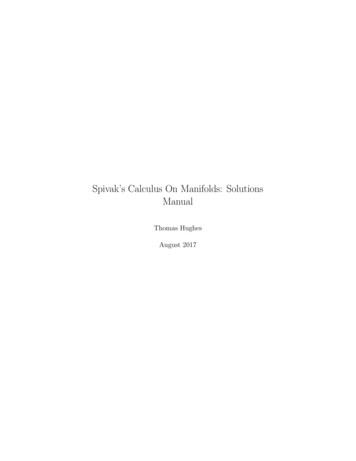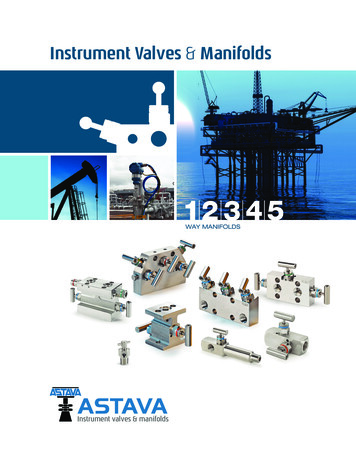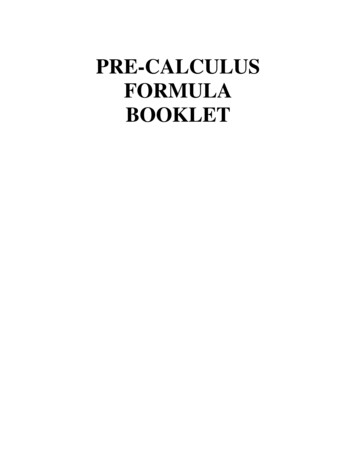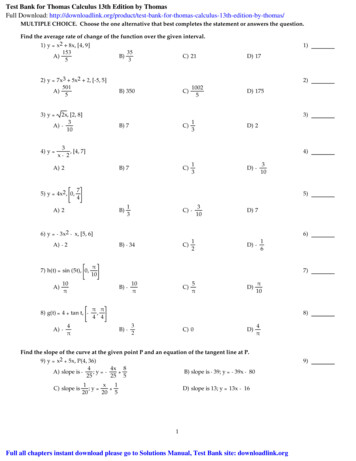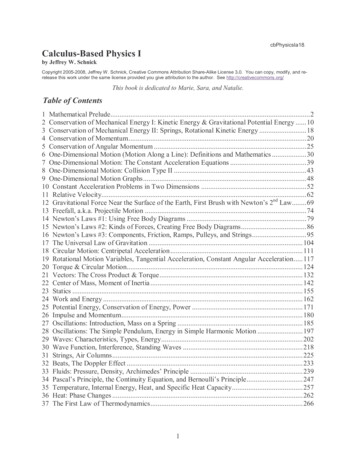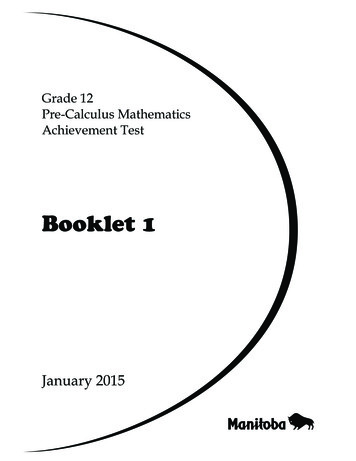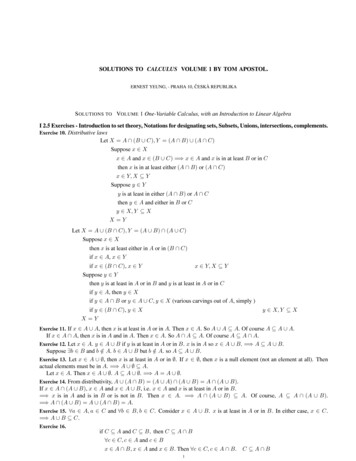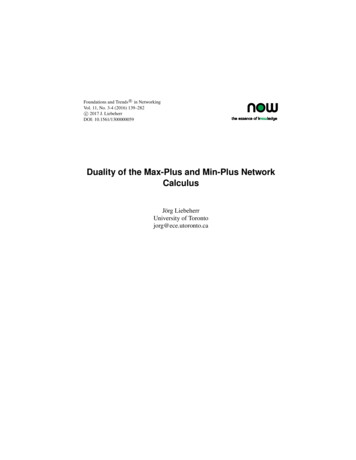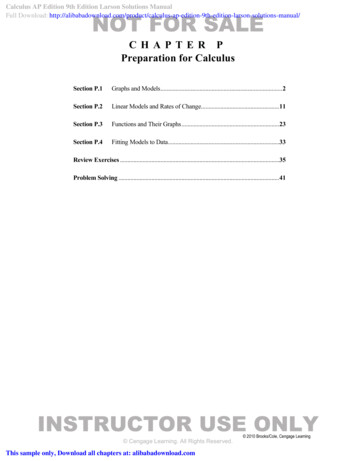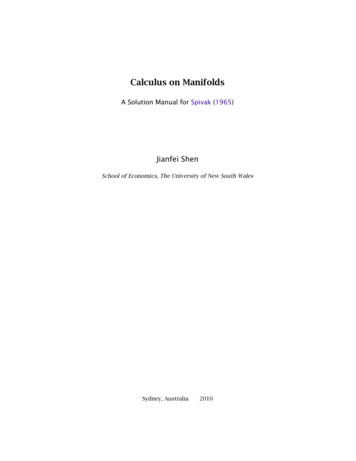
Transcription
Calculus on ManifoldsA Solution Manual for Spivak (1965)Jianfei ShenSchool of Economics, The University of New South WalesSydney, Australia2010
Contents1Functions on Euclidean Space . . . . . . . . . . . . . . . . . . . . . . . . . . . . . . . . . . . . .1.1 Norm and Inner Product . . . . . . . . . . . . . . . . . . . . . . . . . . . . . . . . . . . . . . .1.2 Subsets of Euclidean Space . . . . . . . . . . . . . . . . . . . . . . . . . . . . . . . . . . . .1.3 Functions and Continuity . . . . . . . . . . . . . . . . . . . . . . . . . . . . . . . . . . . . . .11692Differentiation . . . . . . . . . . . . . . . . . . . . . . . . . . . . . . . . . . . . . . . . . . . . . . . . . . . . .2.1 Basic Definitions . . . . . . . . . . . . . . . . . . . . . . . . . . . . . . . . . . . . . . . . . . . . . .2.2 Basic Theorems . . . . . . . . . . . . . . . . . . . . . . . . . . . . . . . . . . . . . . . . . . . . . . .2.3 Partial Derivatives . . . . . . . . . . . . . . . . . . . . . . . . . . . . . . . . . . . . . . . . . . . . .2.4 Derivatives . . . . . . . . . . . . . . . . . . . . . . . . . . . . . . . . . . . . . . . . . . . . . . . . . . . .2.5 Inverse Functions . . . . . . . . . . . . . . . . . . . . . . . . . . . . . . . . . . . . . . . . . . . . .2.6 Implicit Functions . . . . . . . . . . . . . . . . . . . . . . . . . . . . . . . . . . . . . . . . . . . . .131318263438403Integration . . . . . . . . . . . . . . . . . . . . . . . . . . . . . . . . . . . . . . . . . . . . . . . . . . . . . . . .3.1 Basic Definitions . . . . . . . . . . . . . . . . . . . . . . . . . . . . . . . . . . . . . . . . . . . . . .3.2 Measure Zero and Content Zero . . . . . . . . . . . . . . . . . . . . . . . . . . . . . . . .3.3 Fubini’s Theorem . . . . . . . . . . . . . . . . . . . . . . . . . . . . . . . . . . . . . . . . . . . . . .454551514Integration on Chains . . . . . . . . . . . . . . . . . . . . . . . . . . . . . . . . . . . . . . . . . . . . . 554.1 Algebraic Preliminaries . . . . . . . . . . . . . . . . . . . . . . . . . . . . . . . . . . . . . . . . 55References . . . . . . . . . . . . . . . . . . . . . . . . . . . . . . . . . . . . . . . . . . . . . . . . . . . . . . . . . . . . 57Index . . . . . . . . . . . . . . . . . . . . . . . . . . . . . . . . . . . . . . . . . . . . . . . . . . . . . . . . . . . . . . . . . . 59iii
1FUNCTIONS ON EUCLIDEAN SPACE1.1 Norm and Inner ProductI Exercise 1 (1-1 ). Prove that kxk 6Pn ˇˇ i ˇˇiD1 ˇx ˇ.Proof. Let x D x 1 ; : : : ; x n . Then 120n n n ˇ ˇˇ XXXˇˇX22ˇ@ ˇˇx i ˇˇA Dx i D kxk2 :xi Cˇx i x j ˇ iD1i D1i ji D1Taking the square root of both sides gives the result.tu I Exercise 2 (1-2). When does equality hold in Theorem 1-1 (3) kx C y k 6 kxk C ky k ?ˇˇProof. We reprove that ˇhx; yiˇ 6 kxk ky k for every x; y 2 Rn . Obviously, ifx D 0 or y D 0, then hx; yi D kxk ky k D 0. So we assume that x 0 and y 0.We first find some w 2 Rn and 2 R such that hw; yi D 0. Write w D x y .Then0 D hw; yi D hx y; yi D hx; yi 2 ky k2implies thatı D hx; yi ky k2 :Thenkxk2 D kwk2 C k y k2 k y k2 Dˇ hx; yiky k 2:ˇHence, ˇhx; yiˇ 6 kxk ky k. Particularly, the above display holds with equality ifand only if kwk D 0, if and only if w D 0, if and only if x y D 0, if and onlyif x D y .Sincekx C y k2 D hx C y; x C yi D kxk2 C ky k2 C 2 hx; yi 6 kxk2 C ky k2 C 2 kxk ky k 2D kxk C ky k ;1
2CHAPTER 1FUNCTIONS ON EUCLIDEAN SPACEequality holds precisely when hx; yi D kxk jjyjj, i.e., when one is a nonnegativemultiple of the other.tuI Exercise 3 (1-3). Prove that kxy k 6 kxk C ky k. When does equality hold?Proof. By Theorem 1-1 (3) we have kx y k D kx C . y/k 6 kxk C k y k Dkxk C ky k. The equality holds precisely when one vector is a non-positive multiple of the other.tuˇI Exercise 4 (1-4). Prove that ˇ kxkˇky kˇ 6 kxy k. 2PnPy k2 Dyi D kxk2 C ky k2 2 niD1 xi yi iD1 xi 2kxk2 C ky k2 2 kxk ky k D kxk ky k . Taking the square root of both sidesgives the result.tuProof. We have kxI Exercise 5 (1-5). The quantity ky x k is called the distance between x and y .Prove and interpret geometrically the “triangle inequality”: kz xk 6 kz y k Cky x k.Proof. The inequality follows from Theorem 1-1 (3):kzxk D k.zy/ C .yx/k 6 kzy k C kyxk :Geometrically, if x , y , and z are the vertices of a triangle, then the inequalitysays that the length of a side is no larger than the sum of the lengths of theother two sides.tuI Exercise 6 (1-6). If f and g be integrable on Œa; b .ˇRˇ ba. Prove that ˇaˇ R 12 R 12ˇbbf gˇ 6 a f 2 a g2 .b. If equality holds, must f D g for some 2 R? What if f and g are continuous?c. Show that Theorem 1-1 (2) is a special case of (a).Proof.a. Theorem 1-1 (2) implies the inequality of Riemann sums:ˇˇ 011 2 011 2ˇXˇXXˇˇˇf .xi / g .xi / xi ˇˇ 6 @f .xi /2 xi A @g .xi /2 xi A :ˇˇ iˇiiTaking the limit as the mesh approaches 0, one gets the desired inequality.b. No. We could, for example, vary f at discrete points without changingthe values of the integrals. If f and g are continuous, then the assertionis true. In fact, suppose that for each 2 R, there is an x 2 Œa; b with
SECTION 1.13NORM AND INNER PRODUCT 2 g .x/ 0. Then the inequality holds true in an open neighbor 2Rbhood of x since f and g are continuous. So a f g 0 since the integrand is always non-negative and is positive on some subinterval of Œa; b .RbRbRbExpanding out gives a f 2 2 a f g C 2 a g 2 0 for all . Since thequadratic has no solutions, it must be that its discriminant is negative. f .x/c. Let a D 0, b D n, f .x/ D xi and g .x/ D yi for all x 2 Œi 1; i/ for i D 1; : : : ; n.Then part (a) gives the inequality of Theorem 1-1 (2). Note, however, thatthe equality condition does not follow from (a).tuI Exercise 7 (1-7). A linear transformation M W Rn ! Rn is called norm preserving if kM x k D kxk, and inner product preserving if hM x; M yi D hx; yi.a. Prove that M is norm preserving if and only if M is inner product preserving.b. Prove that such a linear transformation M is 1-1 and M1is of the same sort.Proof.(a) If M is norm preserving, then the polarization identity together with thelinearity of M give:hM x; M yi DkM x C M yk2DM yk2kM .xy/k242DkM xkM .x C y/k4xy k2kkx C y k24D hx; yi :If M is inner product preserving, then one has by Theorem 1-1 (4):pphM x; M xi D hx; xi D kxk :kM x k D(b) Take any M x; M y 2 Rn with M x D M y . Then M x0 D hM xM y; M xM yi D hxy; xM y D 0 and soyi Ibut the above equality forces x D y ; that is, M is 1-1.Since M 2 L.Rn / and M is injective, it is invertible; see Axler (1997, Theorem3.21). Hence, M 1 2 L.Rn / exists. For every x; y 2 Rn , we havekMandDMTherefore, M11x; M11 DMMkx y D M ME11 x D kxk ;x ;M M1y D hx; yi :is also norm preserving and inner product preserving.tu
4CHAPTER 1FUNCTIONS ON EUCLIDEAN SPACEI Exercise 8 (1-8). If x; y 2 Rn arethe anglebetween x and y , non-zero, ıydenoted † .x; y/, is defined as arccos hx; yi kxk k k , which makes sense byTheorem 1-1 (2). The linear transformation T is angle preserving if T is 1-1, andfor x; y 0 we have † .Tx; Ty/ D † .x; y/.a. Prove that if T is norm preserving, then T is angle preserving.b. If there is a basis .x1 ; : : : ; xn / of Rn and numbers 1 ; : : : ; n such that Txi D i xi , prove that T is angle preserving if and only if all j i j are equal.c. What are all angle preserving T W Rn ! Rn ?Proof.(a) If T is norm preserving, then T is inner product preserving by the previousexercise. Hence, for x; y 0, † .Tx; Ty/ D arccoshTx; TyikTx k kTyk D arccoshx; yikxk ky k D † .x; y/ :(b) We first suppose that T is angle preserving. Since .x1 ; : : : ; xn / is a basis ofRn , all xi ’s are nonzero. Since † Txi ; Txj D arccosTxi ; Txj !kTxi k Txj ! i xi ; j xjD arccosk i xi k j xj! i j xi ; xjˇ ˇD arccosj i j ˇ j ˇ kxi k kxj k D † xi ; xj ;it must be the case thatˇ ˇ i j D j i j ˇ j ˇ :Then i and j have the same signs.tuI Exercise 9 (1-9). If 0 6 , let T W R2 ! R2 have the matrix!cos sin AD:sin cos Show that T is angle preserving and if x 0, then † .x; Tx/ D .Proof. For every x; y 2 R2 , we have T x; y Dcos sin Therefore,T x; y !sin cos 2!xDyD x2 C y2 D!x cos C y sin :x sin C y cos x; y 2Ithat is, T is norm preserving. Then it is angle preserving by Exercise 8 (a).
SECTION 1.15NORM AND INNER PRODUCTLet x D .a; b/ 0. We first have hx; Txi D a .a cos C b sin / C b . a sin C b cos / D a2 C b 2 cos :Hence,hx; Txi† .x; Tx/ D arccoskxk kTx k D arccos! a2 C b 2 cos D :a2 C b 2tuI Exercise 10 (1-10 ). If M W Rm ! Rn is a linear transformation, show thatthere is a number M such that kM hk 6 M khk for h 2 Rm .Proof. Let M’s matrix be AD ::: a11:::an1a1m:::anm Thena1::: :an a1 ; h::;:nha ; hiM h D Ah Dand so01n DnnE2 XXX 2ai ; h 6kai k khk D @kM hk2 Dkai k2 A khk2 ;i D1i D1iD1pthat is,0BkM hk 6 @pLet M DnXnXi D11Ckai kA khk :kai k and we get the result.tuiD1I Exercise 11 (1-11). If x; yq2 Rn and z; w 2 Rm , show that h.x; z/ ; .y; w/i Dhx; yi C hz; wi and k.x; z/k D kxk2 C kzk2 .Proof. We have .x; z/ ; .y; w/ 2 RnCm . Thenh.x; z/ ; .y; w/i DnXiD1xi yi CmXzj wj D hx; yi C hz; wi ;j D1andk.x; z/k2 D h.x; z/ ; .x; z/i D hx; xi C hz; zi D kxk2 C kzk2 :tu
6CHAPTER 1FUNCTIONS ON EUCLIDEAN SPACEI Exercise 12 (1-12 ). Let .Rn / denote the dual space of the vector space Rn . Ifx 2 Rn , define 'x 2 .Rn / by 'x .y/ D hx; yi. Define M W Rn ! .Rn / by M x D 'x .Show that M is a 1-1 linear transformation and conclude that every ' 2 .Rn / is'x for a unique x 2 Rn .Proof. We first show M is linear. Take any x; y 2 Rn and a; b 2 R. ThenM .ax C by/ D 'axCby D a'x C b'y D a M x C b M y;where the second equality holds since for every z 2 Rn ,'axCby .z/ D hax C by; zi D a hx; zi C b hy; zi D a'x .z/ C b'y .z/ :To see M is 1-1, we need only to show that ıM D f0g, where ıM is the null setof M. But this is clear and so M is 1-1. Since dim .Rn / D dim Rn , M is also onto.This proves the last claim.tuI Exercise 13 (1-13 ). If x; y 2 Rn , then x and y are called perpendicular (ororthogonal) if hx; yi D 0. If x and y are perpendicular, prove that kx C y k2 Dkxk2 C ky k2 .Proof. If hx; yi D 0, we havekx C y k2 D hx C y; x C yi D kxk2 C 2 hx; yi C ky k2 D kxk2 C ky k2 :tu1.2 Subsets of Euclidean SpaceI Exercise 14 (1-14 ). Simple. Omitted. I Exercise 15 (1-15). Prove that x 2 Rn W kxak r is open.Proof. For any y 2 x 2 Rn W kx ak r µ B.aI r/, let " D rthat B.yI "/ B.aI r/. Take any z 2 B.yI "/. Then ka; zk 6 ka; y k C ky; zk ka; y k C " D r:I Exercise 16 (1-16). Simple. Omitted.I Exercise 17 (1-17). Omitted.ka; y k. We showtu
SECTION 1.27SUBSETS OF EUCLIDEAN SPACEI Exercise 18 (1-18). If A Œ0; 1 is the union of open intervals .ai ; bi / suchthat each rational number in .0; 1/ is contained in some .ai ; bi /, show that @A DŒ0; 1 X A.SProof. Let X Œ0; 1 . Obviously, A is open since A D i .ai ; bi /. Then X X Ais closed in X and so X X A D X X A. Since @A D Ax \ X X A D Ax \ .X X A/, itsuffices to show thatxX X A A:(1.1)But (1.1) holds if and only if Ax D X . Now take any x 2 X and any open nhoodU of x in X . Since Q is dense, there exists y 2 U . Since there exists some i suchthat y 2 .ai ; bi /, we know that U \ .ai ; bi / ¿, which means that U \ A ¿,which means that x 2 Ax. Hence, X D Ax, i.e., A is dense in X .tuI Exercise 19 (1-19 ). If A is a closed set that contains every rational numberr 2 Œ0; 1 , show that Œ0; 1 A.Proof. Take any r 2 .0; 1/ and any open interval r 2 I .0; 1/. Then thereexists q 2 Q \ .0; 1/ such that q 2 I . Since q 2 A, we know that r 2 Ax D A. Since0; 1 2 A, the claim holds.tuI Exercise 20 (1-20). Prove the converse of Corollary 1-7: A compact subset ofRn is closed and bounded.Proof. To show A is closed, we prove that Ac is open. Assume that x A, and let Gm D y 2 Rn W kx y k 1 m , m D 1; 2; : : :. If y 2 A, then x y ;hence, kx y k 1 m for some m; therefore y 2 Gm (see Figure 1.1). Thus,SA 1mD1 Gm , and by compactness we have a finite subcovering. Now observethat the Gm for an increasing sequence of sets: G1 G2 ; therefore, afinite union of some of the Gm is equal to the set with the highest index. Thus,K Gs for some s , and it follows that B.xI 1 s/ Ac . Therefore, Ac is open.A1 mxFigure 1.1. A compact set is closedLet A be compact. We first show that A is bounded. Let
8CHAPTER 1FUNCTIONS ON EUCLIDEAN SPACE O D . i; i/n W i 2 Nbe an open cover of A. Then there is a finite subcover . i1 ; i1 /n ; : : : ; . im ; im /n of A. Let i 0 D max fi1 ; : : : ; im g. Hence, A i 0 ; i 0 ; that is, A is bounded.tu I Exercise 21 (1-21 ).a. If A is closed and x A, prove that there is a number d 0 such thatky x k d for all y 2 A.b. If A is closed, B is compact, and A \ B D ¿, prove that there is d 0 suchthat ky x k d for all y 2 A and x 2 B .c. Give a counterexample in R2 if A and B are closed but neither is compact.Proof.(a) A is closed implies that Ac is open. Since x 2 Ac , there exists an open ballB.xI d / with d 0 such that x 2 B.xI d / Ac . Then ky x k d for all y 2 A.(b) For every x 2 B , there exists dx 0 such that x 2 B.xI dx 2/ Ac andky x k dx for all y 2 A. Then the family fB.xI dx 2/ W x 2 Bg is an opencover of B . Since B is compact, there is a finite set fx1 ; : : : ; xn g such that B.x1 I dx1 2/; : : : ; B.xn I dxn 2/ covers B as well. Now let. d D min dx1 2; : : : ; dxn 2 2:Then for any x 2 B , there is an open ball B.xi I xi 2/ containing x and kydi . Hence,kyx k kyxi kkxix k dixi k di 2 D di 2 d:(c) See Figure 1.2.0Figure 1.2.tu
SECTION 1.39FUNCTIONS AND CONTINUITYI Exercise 22 (1-22 ). If U is open and C U is compact, show that there is acompact set D such that C D B and D U .tuProof.1.3 Functions and ContinuityI Exercise 23 (1-23). If f W A ! Rm and a 2 A, show that limx!a f .x/ D b ifand only if limx!a f i .x/ D b i for i D 1; : : : ; m.Proof. Let f W A ! Rm and a 2 A.pIf: Assume that limx!a f i .x/ D b i for i
quadratic has no solutions, it must be that its discriminant is negative. c.Let a D0, b n, f. x /D iand g.x/ Dy ifor all 2„i 1;i for i 1;:::;n. Then part (a) gives the inequality of Theorem 1-1 (2). Note, however, that the equality condition does not follow from (a). t IExercise 7 (1 Author: Jianfei ShenPublish Year: 2010
